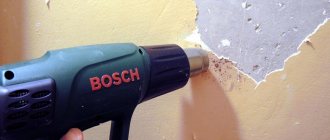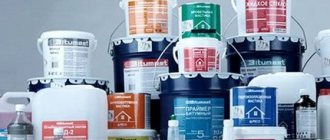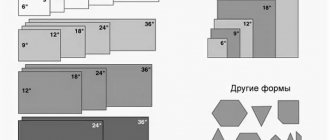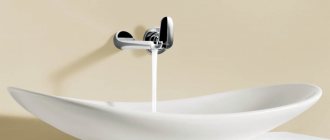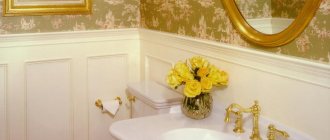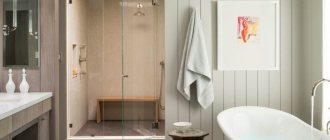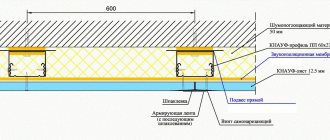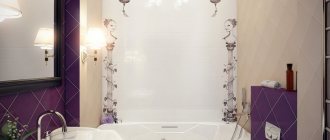Pros and cons of painted walls
People often associate painted walls in the bathroom with Soviet bathrooms, with uneven coloring and ugly, greasy, dirty paint. Of course, such an image cannot inspire inspiration for painting the walls in your home.
Modern paints have a number of advantages that may influence the choice of this material for finishing a bathroom:
- Ease of application and quick repainting of walls to your liking;
- Possibility of using decorative elements - prints, artistic paintings;
- Large selection of colors and textures.
Bathroom paint, however, also has its disadvantages:
- If the room is poorly ventilated, mold and mildew may appear on the walls, which does not linger on the tiles;
- Paint is inferior to ceramics in terms of moisture resistance, although it is protected from this factor.
Choice of color and gloss
The main factors when choosing a matte or glossy finish are: the size of the room and the design of the furnishings, the possibility of its harmonious combination with the style.
Matte coating
Matte gloss is most often used when painting walls in spacious rooms. It is less bright, but more versatile. Smoothes and blurs the outlines of the bathroom, makes the room more comfortable and helps to visually reduce it. Matte walls go well with classic interior styles, pastel colors and smooth lines.
Matte bathroom walls in French Provence style
Applying a matte gloss coating to the walls allows you to hide unevenness and various surface defects.
Glossy surface
It looks more impressive, but even small wall irregularities, stains and stains are especially noticeable with gloss. A room with a glossy shine requires much more effort to maintain it in decent condition. Ideally harmonizes with such interior styles as: modern, minimalism, expressionist movements. It is appropriate to use glossy paints in rooms with large mirror surfaces.
Gloss on the walls will correct the shortcomings of the room and make the bathroom space visually larger
Glossy paints are less susceptible to mechanical stress compared to matte ones.
Color spectrum
When deciding what and how to paint the walls in the bathroom, the choice of color is extremely important, since its influence on the psychosomatic state of a person is undeniable.
When decorating a bath, the most common colors are those associated with the sea and sea waves: various shades of blue and green. This color promotes peace and has a calming, relaxing effect.
The pleasant turquoise color of the walls will remind you of vacation and relaxation at sea
Green coloring of the walls will bring freshness and summer mood to the interior
If the room is small, designers recommend using colors in a light spectrum, as they expand its visual perception. But you should not use exclusively white colors - this may lead to not entirely pleasant associations. White color - must be diluted with warmer and gentler shades or combined with bright decorative elements.
White is a universal color for decorating a small bathroom
The red and white combination will appeal to lovers of a bright and rich interior.
Contrasting colors are often used in the interior of spacious bathrooms. This technique is used to give greater emphasis to individual elements of the room, to highlight and delimit zonal boundaries. A shower stall in an aggressive color scheme looks impressive against a wall painted in calm, pastel colors.
Different colors can be used to zoning space or emphasizing individual functional areas
Depending on the style, it is permissible to use dark colors, even black, but at the same time, it is necessary to strictly maintain proportions.
In a fairly spacious bathroom, gray walls look good, against which white plumbing stands out.
Surface preparation
When starting to paint the bathroom, you need to carry out several preparatory measures. First, the old finish is removed from the surface. If the walls have been painted, a solvent will be needed to remove the paint layer. Ceramic tiles will have to be knocked down. Wallpaper in the bathroom can be removed using a knife or metal spatula, after wetting the surface with water.
If renovations are being carried out in a new apartment, the surface should be carefully plastered and leveled. Only in this case will the paint lie flat and have a neat appearance. Often, in the rough finish, plastering of walls with many flaws and irregularities is allowed. It is recommended to knock down such a coating and replace it with a new layer of plaster.
When the layer of plaster has hardened, you can move on to the next stage - leveling the surfaces with putty. For these purposes, it is best to use a special moisture-resistant and water-emulsion version of this material. It is also recommended to select substances that contain antiseptic and antifungal impurities.
Before painting, the walls also need to be treated with a waterproof primer.
How to paint tiles
If you have properly prepared the tiles for painting, then the painting process itself will not be difficult. For this purpose, you can use a brush, a paint roller or, as mentioned above, an aerosol can of paint. The paint must be applied in two layers - the first (rough) and after it dries (usually 10-12 hours) the finishing one.
Photo gallery: methods of applying paint
If you dilute the paint of the desired shade yourself, make sure that there is enough to paint the entire surface. Otherwise, it will be almost impossible to repeat the shade.
When the paint has completely dried (to guarantee it is better to wait two or three days), you can begin the final stage of painting, namely coating the tiles with varnish. We remind you that it is better to use water-based varnish. The varnish is applied in the same way as paint, in two layers using a brush.
Selecting the necessary tools
To paint the walls in the bathroom you will need a small set of tools that can be bought at any hardware store. If the renovation is carried out in a large room, rollers with a wide surface can be used for painting. If the area to be painted is small, it is worth buying a medium-sized roller.
Using a long-nap roller you can create a textured surface of the paint layer. Short pile is designed to create perfectly smooth or glossy walls.
You will also need brushes for the work - they can be used to paint corners and hard-to-reach places. You also need to buy special cuvette containers in which paint is diluted, tool trays, foam sponges and solvent.
Types of bathroom paints
Today there are many paint options on sale for decorating bathroom and bathroom walls.
- Waterproof paints
Waterproof paint is an acrylic composition that provides a dense and airtight coating. The acrylic mixture is available in a wide variety of shades, allowing you to give your bathroom a unique design. It is worth noting that this type of paint is best applied to a perfectly flat wall with a fresh finish. Another advantage of waterproof acrylic paint is its low price compared to other paints and tiles.
- Latex coatings
Waterproof paints also include latex coating. It prevents the appearance of fungus on the walls and creates a protective layer on the surface. Unlike the acrylic mixture, the latex composition allows steam to pass through, so condensation does not form on the walls. If water does not fall directly on the paint layer (for example, when installing a shower stall), smudges will not appear on the surface and they will have to be washed frequently.
- Water emulsion
Water-based compositions are an excellent moisture-resistant material for finishing a bathroom. Most often the mixture can be found in light colors - white or ivory. When renovating a bathroom, it is recommended to cover the walls with water-based emulsion in those places where there is no direct contact of paint with water, soap and other substances.
- Gloss paint
Glossy paint perfectly reflects light, making the room more spacious and tidy. It is also more stable than textured and matte mixtures, due to the creation of an even protective layer on the surface. The downside of glossy paint is its ability to highlight imperfections in walls, so it can only be applied to a perfectly flat surface.
- Matt paint
Matte paint is often used in modern design, it absorbs light and creates the appearance of a fabric covering on the surface. The matte surface looks very modern and presentable. Unfortunately, among all bath products, matte formulations are the least durable.
- Textured paint
To make wall painting look original and expensive, you can use special textured paint, which allows you to create the effect of an uneven surface. With its help you can create real three-dimensional patterns. This decoration does not require additional decorations - it looks elegant and unusual in itself. In addition, textured paint can disguise unevenness and defects in the walls.
What paint to choose for the bathroom
The choice of paint for the bathroom should be justified not so much by external characteristics as by performance. It is important to choose moisture-resistant compounds that can be washed and not be afraid of the formation of warm steam and water streaks on the surface.
Which ones can be used without odor?
Alkyd and oil compositions, of course, have the best adhesiveness, are not afraid of moisture and can be washed, but such compositions have one characteristic difference - an unpleasant, persistent chemical odor that does not disappear for several weeks.
Water-based, water-depression paints are used without odor. Such compositions not only have no pungent odor, but also dry quickly, they can be washed and repainted many times.
Which ones won't last long?
Water-based paints applied to the entire surface of the wall will not last long due to the fact that you will need to constantly wipe off water and drips, with which the paint itself is subsequently washed off. It is recommended to partially decorate the space with water-based emulsion, and finish the bottom with a more water-resistant material - plastic panels, tiles.
Paints that are not recommended for painting in the bathroom
There are no paints that are strictly prohibited from being used. Relatively all coloring compositions can be used partially or completely. However, in some cases the feasibility of paint is questionable due to its high cost and performance characteristics.
Waterproof
The class of waterproof paint compositions includes silicone, acrylic, enamel and alkyd, as well as latex paints. Such compositions are used not only in the bathroom, but also in the hallway and kitchen, where it is often necessary to remove dirt from surfaces.
Painting the bathroom depending on the style
Having decided on the style of your future bathroom, you can make it much easier for yourself to choose colors and textures of paint for finishing. Let's look at how painted walls fit into the most popular bathroom interior styles.
- Classic. Painting the walls is perfect for a classic-style bathroom. This finish can be combined with ceramic tiles. It is better to choose paint in calm shades.
- High tech. In this style, painting walls in cool colors is encouraged: gray, blue. You can add small quantities of brightly colored elements to your interior. In a high-tech interior, glossy paint will look good, emphasizing the smooth surface of the walls. It is also worth adding glass and mirror elements to the design.
- Provence. The popular style of the “French house” is built from light colors and elegant interior elements. To paint the walls, you should choose the following tones: blue, pink, pistachio, light yellow. Matte paint with an interesting texture will look best in a Provence interior. To decorate the surface, it is best to use a floral pattern, which can be done using a stencil.
- Retro. For a pop art style interior, you should choose a bright combination of shades. The painting of the room can be complemented with drawings in the form of comic books, celebrity posters and geometric patterns.
“Design techniques” when painting tiles
In most cases, tiles painted “one color” look rather “boring”, of course, unless this is a special “designer’s intention”. Therefore, when working, you can use various artistic techniques, thanks to which “boring” painting can turn into a real creative process.
Of course, the coolest option for decorating tiles would be hand painting (this is where the special ceramic paints mentioned above come in handy). But for this you need to either have the talent of an artist, or invite a professional, which is a rather “expensive pleasure”. However, in addition to this, there are enough ways to make the tiles in the bathroom bright and beautiful.
Painting tiles in different colors (video)
One of the most common options for decorating a bathroom is to create a pattern of tiles of different colors. It is also quite possible to create such a mosaic while painting. To do this, the only additional materials you will need is masking tape, which is used to seal the edges of the tiles to prevent paint of the “wrong color” from getting on them and to create smooth boundaries between the tiles.
You can learn more about this technology by watching the following video:
Drawing with a stencil
You can decorate tiles with a pattern using stencils. Moreover, you can make patterns both on each individual tile and create a “big picture”, thereby turning the tiles in the bathroom into a picturesque panel.
You can make stencils yourself by transferring the design you like onto any dense material (for example, cardboard) and then carefully cutting it out with scissors. But it is better to use ready-made stencils for painting, since today there are a great variety of them on the construction market.
You can apply paint to the stencil using a brush or foam pad. A brush will leave behind small strokes, while a swab will give a fairly smooth surface. Depending on the chosen pattern, you can decide which tool is best to use in each specific case.
When using a foam swab, do not press it too hard against the stencil. Otherwise, an excessive amount of paint will be squeezed out, the excess of which will flow under the stencil, which will make the drawing sloppy.
3-D effect for tiles
With a little patience, you can create a relief pattern on the tile or, in fashionable terms, add a 3-D effect to it. To do this, you need to cut out the selected patterns from calico or gauze and stick them on the tile. Then paint the pasted pattern first, and then, with a second layer, the entire tile. Please note that to achieve the best effect, the second layer of paint should be one or two shades darker than the first, and it is recommended to apply it using a special “rough” roller. After drying, a protective layer of varnish is applied to the paint, as in all other cases.
As you can see, you can update an old bathroom interior without much expense, “armed” with just paints, brushes and, of course, imagination. And you don’t have to worry about something not working out for you. After all, if you are dissatisfied with the result of your creativity, the tiles can always be repainted. Good luck with your renovation!
- Author: Vasily
Rate this article:
- 5
- 4
- 3
- 2
- 1
(2 votes, average: 3.5 out of 5)
Share with your friends!
Fighting mold and white plaque with painting
To rid yourself of the appearance of mold and plaque on painted walls, you need to choose a paint that contains an antifungal antiseptic. Don't forget about good ventilation and regular cleaning in the bathroom.
If mold does appear, it can be removed using professional cleaning products or using traditional methods. Household chemicals should be selected according to the type of coating in the bathroom - this information can be found on the packaging of the product. Among the traditional methods for removing mold, the most popular are the use of soda, vinegar solution, bleach and hydrogen peroxide.
Rules for painting a bathroom yourself
Let's summarize some tips for those who decide to paint the walls in the bathroom with their own hands:
- In order not to make a mistake with the choice of paint, you can make a template from a sheet of drywall. It also needs to be covered with plaster and primer, then paint of the selected shade. By applying the template to the wall in the bathroom, you can understand how this color will look in the interior.
- Much attention should be paid to leveling the walls in the bathroom, otherwise even the best paint will look untidy.
- To avoid the appearance of mold, you need to select paint with antifungal substances in its composition.
- To prevent painted walls from losing their appearance over time, you should take care of proper ventilation in the room and regularly clean it.
Bathroom design: decoration elements
Modern water-repellent paints offer a lot of scope for design solutions that can be used when painting bathroom walls. Most often, acrylic compositions are used for such work - they combine good artistic and technical characteristics. Here are a few examples of how to decorate the walls of a room yourself using paint.
Painting walls with a “watercolor” effect, which is very popular in modern interior design, is quite easy to do with your own hands. To do this, you will need to take several shades of acrylic wall paint, an ordinary household sponge and a small container of water. To create a weightless “watercolor” drawing, you need to dip the sponge into the paint, then into water, wring it out completely and apply it to the wall with light touches, as if driving the paint into the surface of the wall.
Another easy and fashionable option for painting walls is a zigzag or chevron print. To create it, the surface is first coated with white paint, and then stripes of a contrasting shade are applied. To make the lines even, masking tape is used as a stencil. Designers recommend using zigzag in light shades in the bathroom interior.
In photographs of a bathroom with a modern design you can often see original prints depicting inscriptions, silhouettes, and ornaments. How to do such a painting without special artistic skills? The answer is simple - for this you need to use ordinary stencils. They are made of durable paper and fixed to the surface using masking tape, and then filled with paint using a special stencil brush or an ordinary household sponge.
In conclusion, we invite readers to look at photographs of bathroom projects using various wall painting techniques. They can easily be repeated with your own hands at minimal cost.
Choosing paint for bathroom walls
The paint must have certain qualities so that the renovation of the room retains its original appearance for a long time. Therefore, before making the final choice of composition, you should familiarize yourself with the advantages and disadvantages of each type of paint.
Acrylic
This is one of the best compositions for finishing the walls of a bathroom. The mixture does not contain harmful or toxic substances and does not adversely affect the well-being and health of residents. The use of respirators is not required during the work. The popularity of the paint is explained by other advantages:
- it is well distributed over the prepared surface, which ensures economical consumption of material;
- painted walls dry relatively quickly (literally in a couple of hours);
- the composition is wear-resistant.
There are no disadvantages as such. There are nuances of use that must be taken into account during repairs. For work, it is advisable to use a small container, where paint can be added if necessary, since in an open large jar the composition can dry out in 5-6 hours. To change the color, it is recommended to dilute the paint with acrylic-based products rather than water.
Alkyd
The basis of the mixture is alkyd resin. Granite, marble chips or very fine ground sand are often used as filler. Due to their high resistance to sunlight and moisture, painted walls can be cleaned regularly with detergents. Advantages of alkyd compositions:
- durability, elasticity;
- ease of application to the surface, short drying period. Therefore, paints are used for interior work;
- Over time, the paint layer does not shrink, fade, or crack.
The composition perfectly tolerates temperature changes and exposure to water. Therefore, it is suitable for decorating surfaces in wet areas (partition, washbasin, shower). The paint perfectly protects any surface: wood, concrete, metal.
Alkyd paints are available in matte, glossy, and semi-matte. Thanks to this, it is easy to create original designs for small bathrooms.
Water-based
The composition must be diluted with water before use. A stable decorative layer is formed after the water-based paint has dried. In the meantime, the composition is not dry, it is easy to wash off. Any surface can be painted with paint.
Advantages of “water emulsion”:
- does not peel off;
- allows air to pass through;
- does not fade when exposed to sunlight;
- rich color palette. It is noteworthy that you can independently obtain the desired shade. To do this, just add a special pigment to neutral-colored paint.
One of the disadvantages is low frost resistance, which is not important when renovating a bathroom in an apartment or house. You should also keep in mind that the decorative layer wears off with frequent washing of the walls.
Oily
Until recently, oil paints were the most popular for decorating bathroom walls. Today such compositions are used, but mainly for painting pipes, batteries, and metal structures. To make the composition, drying oil and a coloring pigment are used. Paints are available in glossy, matte and semi-matte. The main advantage is the price. Main disadvantages of the composition:
- high fire hazard. Since the painting process releases harmful volatile substances, it is recommended to wear gloves, the room is often ventilated, and open fire should not be used in the room;
- short service life of coatings. Over time, the colors fade, the walls acquire a yellow tint;
- It takes a long period of time for surfaces to dry completely.
Rollers, brushes or sprayers are used to apply paint.
Enamel
The basis of enamel compositions is various resins that dry quickly (as soon as the solvent evaporates). In terms of technical indicators, enamels are superior to oil paints. The main advantages of the mixtures:
- fast drying process. It takes literally 20-30 minutes, this is determined by the ambient temperature;
- The decorative layer is highly wear-resistant. Painted walls in the bathroom are easy to clean; the paint does not deteriorate from cleaning products.
Disadvantages include toxicity and fire hazard. Therefore, it is recommended to ventilate the room well during work.
Traditional tools (brushes, rollers) are used to apply paint. If the enamels thicken, then the compositions are diluted with solvents (white alcohol, turpentine, solvent).
Silicate
The main binding element of the paint is liquid potassium glass, which gives the decorative layer special strength. A layer of paint can maintain its original appearance for about 20 years. Most often, the composition is used for painting brick or concrete walls. Positive traits:
- high moisture resistance;
- vapor permeability;
- resistance to ultraviolet radiation;
- resistance to temperature changes;
- the composition is not affected by microorganisms, mold or fungus.
Naturally, the paint also has negative qualities: the composition is not elastic, so small cracks are not filled. It is highly toxic, so it is important to use protective equipment during work and especially take care of your eyes. The high strength of the decorative layer makes it difficult to remove if necessary.
Rollers and brushes are used to apply the composition. The layer dries completely after 12 hours.
